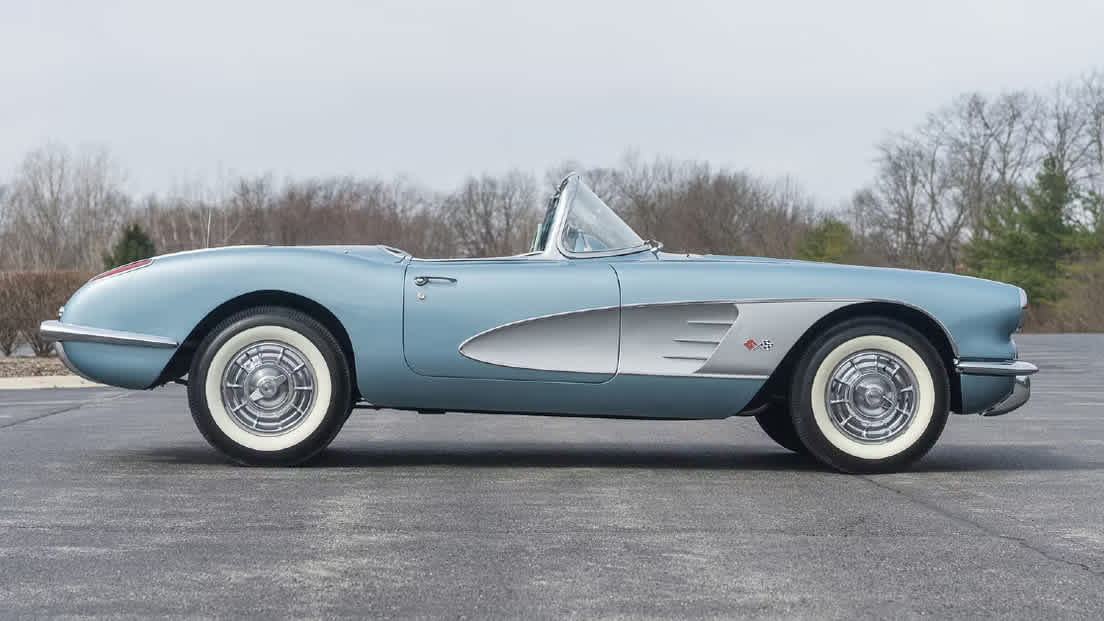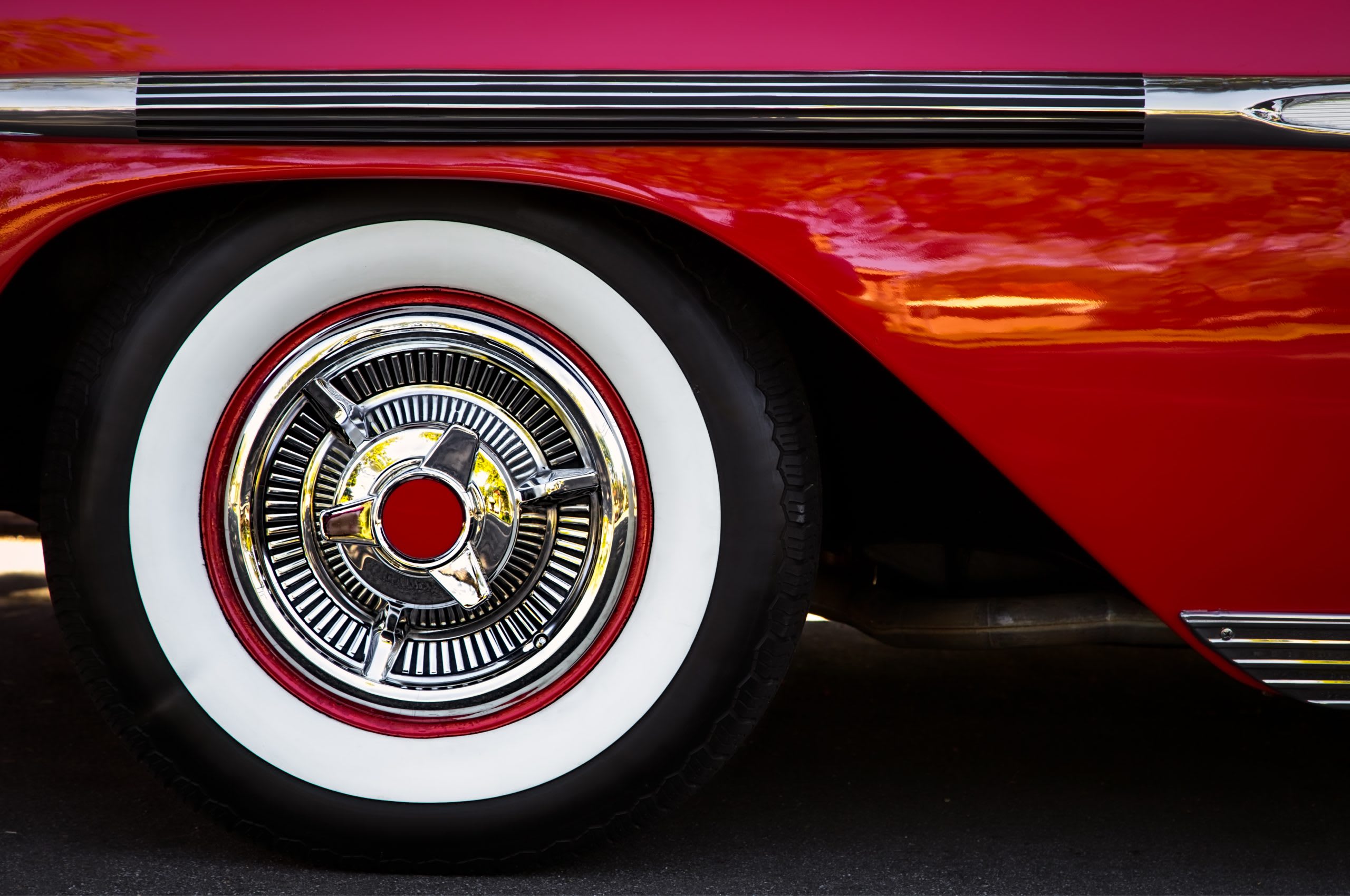Tire News & Information
Free shipping
Best price guarantee
SimpleCrew exclusive savings
0% financing options
Tire replacement coverage
24/7 roadside assistance
Easy returns

Whitewall tires remain one of the most iconic styling elements in automotive history. These distinctive tires with their characteristic white sidewalls have adorned everything from luxury sedans to hot rods for over a century.
The appeal of whitewall tires extends far beyond mere aesthetics. Car enthusiasts and collectors recognize them as essential components for authentic restorations and period-correct builds that capture the elegance of bygone eras.
Today's market offers various whitewall options for classic car owners seeking that vintage look. Modern manufacturing techniques have made these specialty tires more accessible while maintaining the timeless style that defined American automotive culture.
What Are Whitewall Tires?
Whitewall tires feature a distinctive white stripe or band on the sidewall that sets them apart from standard all-black tires. This white section can range from a thin pinstripe to a bold three-inch band, depending on the specific style and era being replicated. The white coloring creates a striking visual contrast against the black tread area, adding an element of sophistication and classic appeal to any vehicle.
The original whitewall tires emerged from a simple manufacturing reality: pure rubber is naturally white. Early tire makers discovered that adding zinc oxide to rubber compounds improved durability, which maintained the white color throughout the tire. When manufacturers began adding carbon black to the tread area for enhanced wear resistance and longevity, they inadvertently created the first whitewall appearance—black tread with white sidewalls that became a defining characteristic of early automotive style.
Modern whitewall tire production differs significantly from these early methods. Today's manufacturers typically apply white rubber strips or specialized white paint during the tire-building process. This approach allows for precise control over the whitewall width and placement while ensuring the white area bonds permanently to the tire structure. The result is a more durable and consistent appearance that resists yellowing and wear better than early whitewall designs.
Available styles cater to different eras and aesthetic preferences:
- Wide Whitewall Tires: Feature bands measuring 2-3 inches in width; authentic for 1950s and early 1960s vehicles
- Narrow Whitewall Tires: Display thinner stripes from 1/4 to 1 inch wide; popular on late 1960s and 1970s models
- Raised White Letter Tires: Show raised white lettering instead of stripes; favored on muscle cars and performance vehicles
- Pin Stripe Whitewalls: Offer the thinnest white accent, typically under 1/4 inch; subtle elegance for luxury cars
These classic styling elements transform ordinary vehicles into head-turning showpieces. Whether adorning a meticulously restored 1957 Chevrolet Bel Air or adding vintage flair to a custom hot rod, whitewall tires provide an unmistakable touch of automotive elegance that modern all-black tires simply cannot match.
The History Behind Whitewall Tires

Early Development (1900s-1920s)
In the early days of automotive tires, manufacturers used natural rubber, which resulted in completely white tires. As the industry advanced, carbon black was introduced to the tread area to improve wear and longevity. This innovation led to the classic whitewall look, with the sidewalls retaining their original white color while the tread became black.
Peak Popularity (1930s-1960s)
By the 1930s, whitewall tires were embraced for their stylish appeal, becoming a hallmark of elegance and sophistication. They featured prominently on many vehicles during the 1940s and 1950s, symbolizing luxury and status. Their distinctive look made them a favorite among car owners seeking to enhance the visual appeal of their automobiles.
The Decline (1970s-1980s)
During the 1970s, the automotive industry saw a shift towards more practical tire designs. Radial tires, known for their enhanced performance and durability, gained traction, while all-black tires were easier to maintain. Consequently, whitewall tires transitioned to a niche market, favored by enthusiasts who appreciated their unique aesthetic and historical significance.
Different Types of Whitewall Tire Styles
Wide Whitewall Tires
Wide whitewall tires are known for their bold white stripe, typically spanning 2-3 inches. This iconic style is ideal for recreating the classic look of vehicles from the mid-20th century. Enthusiasts often select these tires to capture the luxurious appearance that characterized cars of the 1950s and 1960s, with many specialty manufacturers dedicated to producing these authentic designs.
Narrow Whitewall Tires
Narrow whitewall tires present a more understated style, featuring a slender stripe usually between 1/4 and 1 inch wide. This design became fashionable in the late 1960s and continued into the 1970s, complementing the sleek lines of cars from this era. The narrower stripe is simpler to maintain, making it a popular choice for those who prefer subtle elegance without sacrificing visual appeal.
Raised White Letter Tires
Raised white letter tires add a sporty touch by showcasing raised white text on the sidewall. Favored by muscle car and performance vehicle owners, these tires often highlight the brand or model of the tire. They provide a dynamic appearance while maintaining a connection to classic styling, appealing to drivers who enjoy both performance and a distinctive look.
Why Choose Whitewall Tires for Your Vehicle
Whitewall tires bring a distinct charm that enhances the overall look of vintage cars. They are vital for achieving an authentic restoration, ensuring classic vehicles reflect their true era. The bold contrast of the white sidewall adds a unique flair, transforming any classic car into a head-turner.
For those participating in car shows and concours events, authenticity is key, and whitewall tires provide that finishing touch. They highlight the meticulous efforts put into a restoration, making vehicles stand out in a sea of standard options. Whether adorning a 1940s luxury sedan or a 1960s muscle car, these tires evoke the golden age of automotive design.
Available in both traditional bias-ply and modern radial constructions, whitewall tires cater to diverse needs. Bias-ply options capture the original driving experience, while radial tires deliver enhanced performance for regular driving. Selecting the right whitewall tires can also boost a vehicle’s value, appealing to collectors and enthusiasts alike.
Whitewall vs Blackwall Tires: Key Differences
Performance and Durability
Blackwall tires are known for their rugged construction, utilizing carbon black for enhanced resilience. This composition ensures they withstand daily wear and tear with ease. While both blackwall and whitewall tires benefit from modern radial technology, blackwall options continue to excel in longevity.
Whitewall tires, on the other hand, shine with their distinctive style but demand a bit more care to maintain their iconic appearance. Advances in tire manufacturing have introduced radial designs to whitewalls, providing a balanced mix of performance and classic aesthetics.
Maintenance Requirements
Keeping whitewall tires looking pristine involves routine cleaning to maintain their bright appearance. Dedicated whitewall cleaners help prevent discoloration and keep the white sections vivid. Blackwall tires, however, are adept at concealing dirt and blemishes, making them a practical choice for minimal upkeep.
The visibility of scuffs on white sidewalls means regular inspection and gentle care are necessary to preserve their standout look. This ongoing maintenance ensures they remain a focal point on any vehicle.
Cost Considerations
Whitewall tires often command a premium due to their unique design and limited availability. Specialty sizes might require custom manufacturing, contributing to their higher cost. Despite these factors, installation expenses remain comparable to blackwall tires, allowing for a decision based on personal preference rather than financial constraints.
How to Maintain and Clean Whitewall Tires
Essential Cleaning Supplies
To keep whitewall tires looking sharp, gather the right supplies. Choose gentle whitewall tire cleaners that avoid abrasive chemicals to protect the sidewalls. Opt for soft-bristle brushes to prevent damage, and use microfiber towels for effective drying. A good sealant can also help preserve the tire's bright appearance.
Cleaning Process
Begin by rinsing the tires thoroughly to clear away surface dirt. Apply the whitewall cleaner as instructed, ensuring it covers all necessary areas. Use a soft brush to carefully clean the white sections with gentle, circular strokes. After scrubbing, rinse the tires thoroughly and dry with clean towels. A protective finish can be applied to help prevent discoloration and maintain the tire's shine.
Maintenance Tips
Consistent care is key to keeping whitewalls in top condition. Clean them regularly to prevent buildup and maintain their bright look. When parking, choose shaded areas to reduce sun exposure and fading. Be cautious around curbs to avoid marks, and regularly check for any signs of wear or discoloration to address issues swiftly.
Where to Buy Quality Whitewall Tires Today
Specialty Tire Retailers
Begin your search for quality whitewall tires with specialty tire retailers. These stores often cater to vintage and classic car enthusiasts, providing a wide array of options that honor the original designs. You'll find retailers offering authentic reproductions, ensuring your vehicle retains its classic charm.
Online platforms further enhance convenience by presenting a broad selection of sizes and styles. Many include detailed buying guides to assist in selecting the perfect whitewall tires for your needs, making the shopping experience seamless and informed.
Popular Whitewall Tire Options
Several brands excel in offering diverse whitewall tire options, each suited to specific tastes and vehicle requirements. American Classic is renowned for its nostalgic designs, available in both bias-ply and modern radial constructions. These options provide a balance of traditional appearance and contemporary performance.
For a sportier edge, premium sport whitewall tires are ideal for lowriders and custom builds. Specialty manufacturers deliver various whitewall widths and styles, allowing customization to match your vehicle’s unique flair. This variety ensures a perfect fit for any classic automobile.
What to Consider When Purchasing
Selecting the right whitewall tires involves key considerations to ensure they meet your vehicle's needs. Confirming the correct size and load rating is crucial for safety and performance. Decide between bias-ply for a vintage feel or radial tires for improved handling and lifespan.
Choose a whitewall width that complements your car's design and era. Check for a matching spare tire to maintain uniformity. Lastly, comparing warranties and return policies can offer additional peace of mind, making your investment in whitewall tires a confident choice.
Whether you're restoring a classic car to its original glory or adding vintage flair to your daily driver, whitewall tires offer that perfect finishing touch. The right set transforms any vehicle into a rolling piece of automotive history. When you're ready to embrace this timeless style, we make it easy to shop for tires online and find the best deals with our extensive selection and expert guidance to help you find the perfect whitewalls for your ride.
Ready to find the perfect tires?
Search By